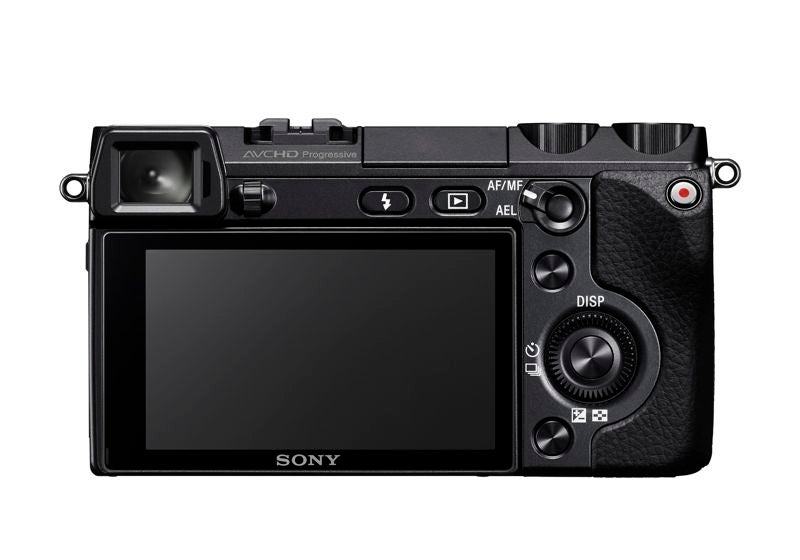The NEX-7 is Sony's answer to the need for a high-end Compact System Camera. But with the Alpha A77 at a close price point is this shrunken-down CSC all its cracked up to be? The WDC Sony NEX-7 review takes a look...
Sony NEX-7 Review
Design
Sony NEX-7 review – Design
The NEX-7 is, we have to say, a curious-looking beast. Arguably the NEX-series as a whole has never had design elegance as its forte but, in part due to the addition of the viewfinder and additional control wheels, the NEX-7 looks more prototype than final piece to our eyes. However, the lightweight magnesium alloy body feels sturdy in the hand and the camera is undoubtedly well made.
 When the first NEX models made their way to market we loved most of what we saw, excluding the clunky menu system that was, by and large, interior to the camera’s virtual menus. The NEX-7 amps things up a great deal with the inclusion of an AEL/AF-MF switch and two rotational wheels to the top right of the camera’s rear, plus the left, right and centre d-pad and lower function button are all customisable.
When the first NEX models made their way to market we loved most of what we saw, excluding the clunky menu system that was, by and large, interior to the camera’s virtual menus. The NEX-7 amps things up a great deal with the inclusion of an AEL/AF-MF switch and two rotational wheels to the top right of the camera’s rear, plus the left, right and centre d-pad and lower function button are all customisable.
The centre d-pad button opens a ‘Custom’ menu where it’s possible to set five main controls, selecting from AF/MF Select, Autofocus Mode, Autofocus Area, Face Detection, Smile Shutter, Soft Skin Effect, Quality, ISO, White Balance, Metering, DRO/HDR, Picture Effect, Creative Style, Flash Mode or no selection. The on-screen menu is a partial success, but as it’s only possible to define five options at the most there may be one or two settings that have to still be accessed via the menus.
Other manufacturers take the approach of putting far more settings into on-screen displays, such as the Panasonic Lumix G-series’ decision to include multiple screens where drag and drop options can be positioned in your preferred order. Sony’s on the right foot and moving forward to clean up the first generation of NEX-series menu issues, but there’s more that could be done still.
 The NEX-7’s dual control wheel design is akin to the dual thumbwheel system you’d find on many higher-spec DSLRs. But unlike those designs the NEX positions these dials side by side instead of one to the front and one to the rear of the camera. It looks a little odd, though isn’t a problem in use as the position of your thumb sits naturally towards them. As the NEX-7’s viewfinder is placed at the polar opposite of the camera body it also prevents one’s face from being in the way of these dials when shooting. The one big problem we did find was the control wheel closest to the camera’s outer edge would frequently get knocked and then shift the exposure compensation by 0.3-0.7EV in either Programme, Aperture Priority or Shutter Priority modes. While the NEX-7 offers a lot of button customisation it’s not possible to deactivate these control wheels – so keep a close eye on the display to ensure the settings are as you expect them to be.
The NEX-7’s dual control wheel design is akin to the dual thumbwheel system you’d find on many higher-spec DSLRs. But unlike those designs the NEX positions these dials side by side instead of one to the front and one to the rear of the camera. It looks a little odd, though isn’t a problem in use as the position of your thumb sits naturally towards them. As the NEX-7’s viewfinder is placed at the polar opposite of the camera body it also prevents one’s face from being in the way of these dials when shooting. The one big problem we did find was the control wheel closest to the camera’s outer edge would frequently get knocked and then shift the exposure compensation by 0.3-0.7EV in either Programme, Aperture Priority or Shutter Priority modes. While the NEX-7 offers a lot of button customisation it’s not possible to deactivate these control wheels – so keep a close eye on the display to ensure the settings are as you expect them to be.
 But why the NEX-7 has no physical mode dial is one design decision that’s beyond us. A camera at this level that demands menu digging to shift between manual controls has missed part of its very purpose.
But why the NEX-7 has no physical mode dial is one design decision that’s beyond us. A camera at this level that demands menu digging to shift between manual controls has missed part of its very purpose.
Also on the rear of the camera is a 3in, 921k-dot LCD is mounted on a tilt-angle bracket for vertical adjustment, but it’s the inclusion of the built-in 2.4m-dot OLED electronic viewfinder (EVF) that makes the NEX-7 extra special.
If you purchase the NEX-7 with the 18-55mm kit lens then it comes in a special black finish to match the body. A small detail, perhaps, but we do like refinements such as this.





